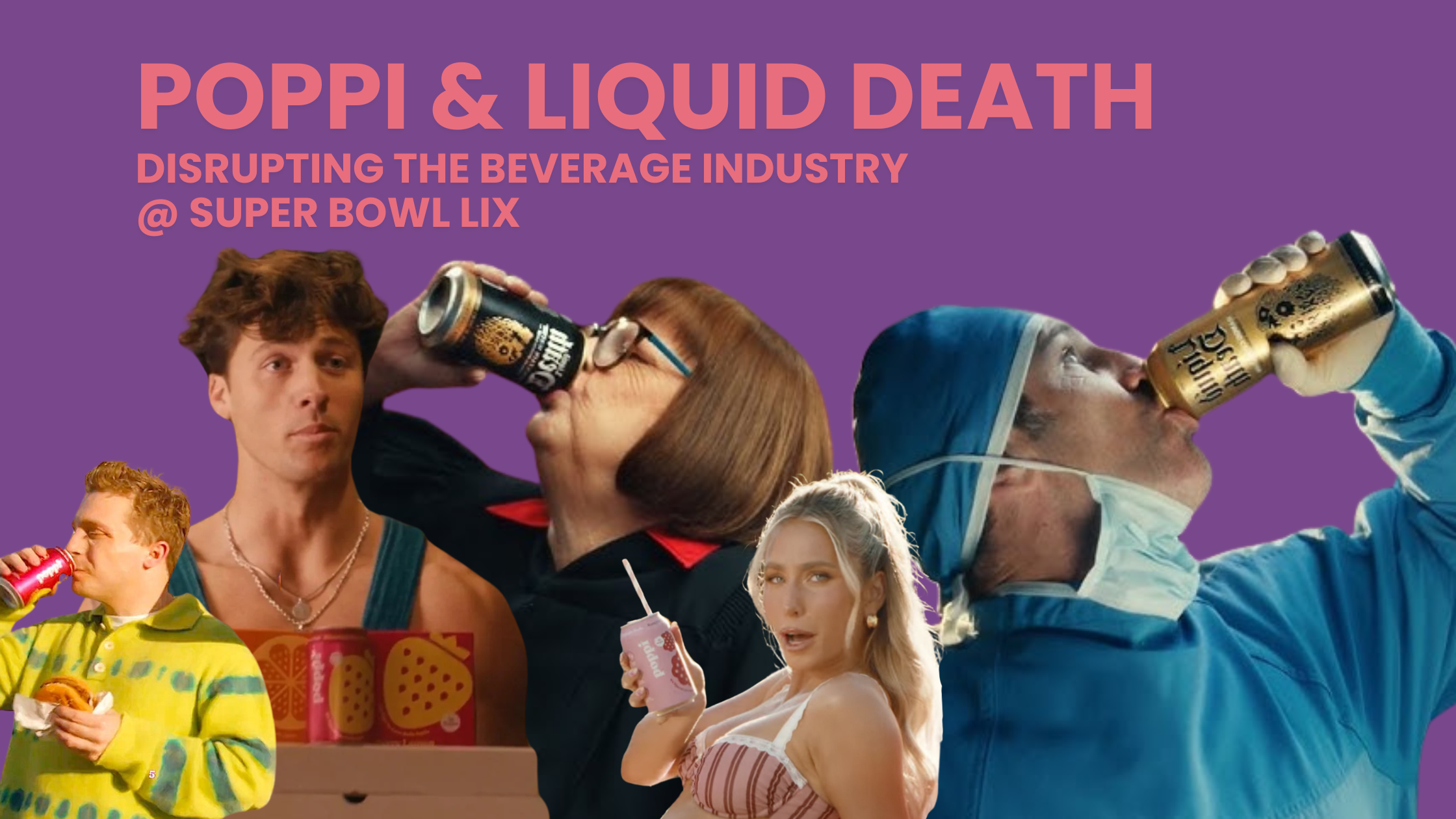Move aside Beer Dads, Sloths, and Clydesdales (even though we deeply loved these commercials), our minds were on the challenger non-alcoholic beverage brands: Poppi and Liquid Death. Both operate in the cutthroat red ocean of the beverage industry, where competition is fierce, and differentiation is the key to survival. Yet, they’ve carved out distinct identities that have fueled their rapid growth:
- Poppi – A functional soda alternative, positioned within the health & wellness space. It competes with traditional sodas but stands out with prebiotic benefits and a gut-health focus.
- Liquid Death – A premium canned water brand, but with the branding, packaging, and marketing of an energy drink or craft beer—making it feel rebellious in a category as basic as bottled water.
Both brands used bold segmentation, category-defying positioning, and disruptive marketing tactics to turn heads during the Super Bowl. Their campaigns offer a masterclass in how challenger brands can thrive in saturated markets, redefine categories, and create blue oceans—winning over consumers through strong emotional connections, clear value propositions, and unforgettable advertising. Let’s break down exactly how they did it.
Poppi’s Super Bowl commercial was designed to speak directly to Gen Z and millennials, tapping into influencer marketing, relatable struggles, and a strong brand narrative. The ad strategically highlighted why soda lovers are looking for a healthier alternative and positioned Poppi as the perfect solution. By combining viral personalities with a clear message, the brand captured attention and strengthened relationships with new and existing customers.
Marketing Tactics in Play
- Influencers: The commercial featured a star-studded lineup of influencers, ensuring instant credibility and reach among younger audiences. Recognizable faces like Alix Earle and Jake Shane delivered snackable, meme-worthy lines—“Stop spiraling, get a Poppi” and “It’s good, right?”—which felt authentic, reinforcing trust and sparking conversations on social media.
- Pain Points: The first half of the commercial zeroed in on a common struggle—wanting the taste of soda but not the sugar and artificial ingredients. It acknowledged the frustration of unsatisfying alternatives, reducing the hesitation that comes with trying a new product. This approach mitigates loss aversion, reassuring viewers that Poppi isn’t just another “healthy” drink—it’s a true soda replacement.
- Product Benefits: The second half of the ad effortlessly transitioned into the solution, showcasing the taste, benefits, and experience of drinking Poppi. The final five seconds were key, visually reinforcing the brand promise and leaving a lasting impression. Rather than just telling viewers why they should try Poppi, the ad showed them, making it easy to imagine swapping their usual soda for something better.
Did Poppi, Pop Off too much?
While the commercial was effective in connecting with its target market, the brand has sparked significant discussion regarding its marketing strategy and expenditures. The approach included a full minute commercial (not the typical 30 seconds), casting prominent influencers such as Jake Shane, Alix Earle, and Rob from Love Island, while also distributing branded vending machines to about 30 influencers (allegedly worth $25K each). This prompted direct competitor OLIPOP to respond with some quick calculations on the vending machines, emphasizing consumer skepticism about the investment. Overall, these choices have led to criticism for being extravagant and potentially out of touch.
It has become a hot topic on social media, with critics arguing that such lavish spending might not resonate with the average consumer and could be seen as wasteful. This raises important questions about whether Poppi’s aggressive marketing tactics and substantial financial outlay were justified, or if they risk alienating potential customers.
In our opinion, Poppi, popped off a little too much with their marketing spend in this instance.
Liquid Death stuck to its rebellious brand identity for its Super Bowl debut, using shock value, humor, and clever associations to grab attention. Instead of focusing on health benefits, the brand challenged consumer perceptions, making people rethink why canned water deserves a place in their routine.
Marketing Tactics in Play
- Clever Associations: At first glance this ad looks like a beer ad. Liquid Death plays on consumer expectations by mimicking the style of big beer commercials, making canned water feel more familiar. This reduces resistance to trying something new—after all, if people are used to cracking open a can of beer, why not a can of water?
- Shock Value: The “Drinking on the Job” theme grabs attention by featuring jobs where drinking is obviously not okay—pilots, surgeons, judges, and more. This unexpected twist makes the ad memorable and drives conversation, whether people find it funny or controversial. The shock factor helps the brand stand out in a crowded Super Bowl ad lineup.
- Audio: The ad’s repetitive, beer-style jingle—“Drink on the job, drink on the job!”—gets stuck in your head, reinforcing the brand name long after the commercial ends. This earworm effect ensures Liquid Death stays top of mind when consumers are choosing a drink.
To stand out as a challenger brand, you must create a disruption, and these two brands successfully achieved that. Poppi leaned into influencer culture and health-conscious messaging, while Liquid Death doubled down an edgy POV with shock value. Proving that category disruption isn’t just about product innovation—it’s about storytelling, positioning, and cultural relevance.
As more challenger brands enter the scene, the takeaway is clear: standing out requires more than just a great product—it demands fearless, culture-shaping marketing.

